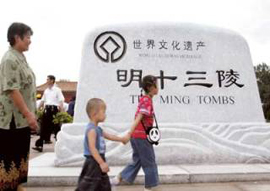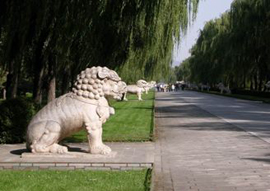Standing in the Spirit Way at the Ming Tombs looking back towards the entry gate, the Ming Dynasty  Tombs (Thirteen Tombs of the Ming Dynasty) are located some 50 kilometers due North of Beijing at an especially selected site. The site was chosen by the third Ming Dynasty emperor Yongle (1402 - 1424), who moved the Capital City of China from Nanjing to the present location of Beijing. He is credited with envisioning the layout of the ancient city of Beijing as well as a number of landmarks and monuments located therein. After the construction of the Imperial Palace (the Forbidden City) in 1420, the Yongle Emperor selected his burial site and creating his own mausoleum. Tombs (Thirteen Tombs of the Ming Dynasty) are located some 50 kilometers due North of Beijing at an especially selected site. The site was chosen by the third Ming Dynasty emperor Yongle (1402 - 1424), who moved the Capital City of China from Nanjing to the present location of Beijing. He is credited with envisioning the layout of the ancient city of Beijing as well as a number of landmarks and monuments located therein. After the construction of the Imperial Palace (the Forbidden City) in 1420, the Yongle Emperor selected his burial site and creating his own mausoleum.
From the Yongle Emperor onwards, 13 Ming Dynasty Emperors were buried in this area. The tombs of the first two Ming Emperors are located near Nanjing (the capital city during their reigns). Emperor  Jingtai was also not buried here as the Emperor Tianshun had denied Jingtai an imperial burial but was instead buried west of Beijing. The last Emperor Chongzhen who hung himself in April, 1644 was the last to be buried here, named Si Ling by the Qing emperor but on a much smaller scale than his predecessors.During the Ming dynasty, the tombs were off limits to commoners but in 1644 Li Zicheng’s army ransacked and set many of the tombs on fire before advancing and capturing Beijing in April of that year. Jingtai was also not buried here as the Emperor Tianshun had denied Jingtai an imperial burial but was instead buried west of Beijing. The last Emperor Chongzhen who hung himself in April, 1644 was the last to be buried here, named Si Ling by the Qing emperor but on a much smaller scale than his predecessors.During the Ming dynasty, the tombs were off limits to commoners but in 1644 Li Zicheng’s army ransacked and set many of the tombs on fire before advancing and capturing Beijing in April of that year. |
